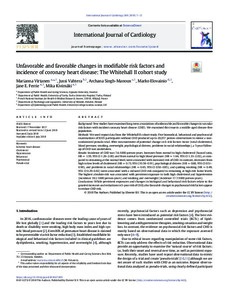Unfavorable and favorable changes in modifiable risk factors and incidence of coronary heart disease: The Whitehall II cohort study
Marko Elovainio; Mika Kivimäki; Archana Singh-Manoux; Jane E. Ferrie; Marianna Virtanen; Jussi Vahtera
Unfavorable and favorable changes in modifiable risk factors and incidence of coronary heart disease: The Whitehall II cohort study
Marko Elovainio
Mika Kivimäki
Archana Singh-Manoux
Jane E. Ferrie
Marianna Virtanen
Jussi Vahtera
Elsevier Ireland Ltd
Julkaisun pysyvä osoite on:
https://urn.fi/URN:NBN:fi-fe2021042719516
https://urn.fi/URN:NBN:fi-fe2021042719516
Tiivistelmä
Background
Few studies have examined long-term associations of unfavorable and favorable changes in vascular risk factors with incident coronary heart disease (CHD). We examined this issue in a middle-aged disease-free population.
Methods
We used repeat data from the Whitehall II cohort study. Five biomedical, behavioral and psychosocial examinations of 8335 participants without CHD produced up to 20,357 person-observations to mimic a non-randomized pseudo-trial. After measurement of potential change in 6 risk factors twice (total cholesterol, blood pressure, smoking, overweight, psychological distress, problems in social relationships), a 5-year follow-up of CHD was undertaken.
Results
Incidence of CHD was 7.4/1000 person-years. Increases from normal to high cholesterol (hazard ratio, HR = 1.59, 95% CI 1.26–2.00) and from normal to high blood pressure (HR = 1.64, 95% CI 1.33–2.03), as compared to remaining at the normal level, were associated with increased risk of CHD. In contrast, decreases from high to low levels of cholesterol (HR = 0.73, 95% CI 0.58–0.91), psychological distress (HR = 0.68, 95% CI 0.51–0.90), and problems in social relationships (HR = 0.65, 95% CI 0.50–0.85), and quitting smoking (HR = 0.49, 95% CI 0.29–0.82) were associated with a reduced CHD risk compared to remaining at high risk factor levels. The highest absolute risk was associated with persistent exposure to both high cholesterol and hypertension (incidence 18.1/1000 person-years) and smoking and overweight (incidence 17.7/1000 person-years).
Conclusions
While persistent exposures and changes in biological and behavioral risk factors relate to the greatest increases and reductions in 5-year risk of CHD, also favorable changes in psychosocial risk factors appear to reduce CHD risk.
Few studies have examined long-term associations of unfavorable and favorable changes in vascular risk factors with incident coronary heart disease (CHD). We examined this issue in a middle-aged disease-free population.
Methods
We used repeat data from the Whitehall II cohort study. Five biomedical, behavioral and psychosocial examinations of 8335 participants without CHD produced up to 20,357 person-observations to mimic a non-randomized pseudo-trial. After measurement of potential change in 6 risk factors twice (total cholesterol, blood pressure, smoking, overweight, psychological distress, problems in social relationships), a 5-year follow-up of CHD was undertaken.
Results
Incidence of CHD was 7.4/1000 person-years. Increases from normal to high cholesterol (hazard ratio, HR = 1.59, 95% CI 1.26–2.00) and from normal to high blood pressure (HR = 1.64, 95% CI 1.33–2.03), as compared to remaining at the normal level, were associated with increased risk of CHD. In contrast, decreases from high to low levels of cholesterol (HR = 0.73, 95% CI 0.58–0.91), psychological distress (HR = 0.68, 95% CI 0.51–0.90), and problems in social relationships (HR = 0.65, 95% CI 0.50–0.85), and quitting smoking (HR = 0.49, 95% CI 0.29–0.82) were associated with a reduced CHD risk compared to remaining at high risk factor levels. The highest absolute risk was associated with persistent exposure to both high cholesterol and hypertension (incidence 18.1/1000 person-years) and smoking and overweight (incidence 17.7/1000 person-years).
Conclusions
While persistent exposures and changes in biological and behavioral risk factors relate to the greatest increases and reductions in 5-year risk of CHD, also favorable changes in psychosocial risk factors appear to reduce CHD risk.
Kokoelmat
- Rinnakkaistallenteet [19207]
